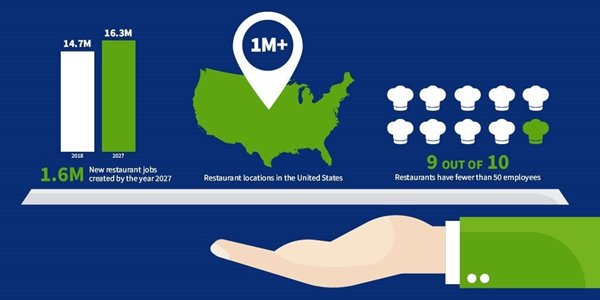The restaurant industry is ever changing, but one thing remains consistent – it’s big business. Take a look at these recent statistics from the National Restaurant Association:

- 1 million+: Restaurant locations in the United States
- 14.7 million: Restaurant industry employees
- 1.6 million: New restaurant jobs created by the year 2027
- 10%: Restaurant workforce as part of the overall U.S. workforce
- $799 billion: Restaurant industry sales
A few more restaurant industry statistics according to the National Restaurant Association’s 2017 Pocket Factbook:
- More than 9 in 10 restaurants have fewer than 50 employees
- More than 7 in 10 restaurants are single-unit operations
- The restaurant industry is expecting employment to reach 16.3 million by 2027
- Restaurant industry sales are projected to total 4 percent of the U.S. gross domestic product

Inside the Numbers
Now let’s take a closer look at what some of these numbers mean; the increase in business volume means growth in the restaurant workforce, as evident by the rise of employees in the industry from 12.5 million to 14.7 as of 2017. In addition, the final two bullets above highlight another trend – the majority of restaurants are small businesses (fewer than 50 employees, single-unit).
When looking at these restaurant industry statistics in particular through an insurance industry lens, a growing workforce means potential for an increase in injuries on the job for employees of small businesses. We recently compiled a restaurant risk report based on our claims data* to further examine the types of employee injuries that occur, and their impact on the employer. Here is what we found:

Cuts, punctures or scrapes make up a third of
restaurant claims reported – not surprising for an industry where slicing and dicing plays a major role in prepping food. You might be surprised to learn, however, that our data also shows the two highest cause of injury categories for restaurant workers on premises were fall or slip and strain or injury by holding or carrying. Employees who injured multiple body parts in a fall or who strained their wrists or hands while carrying were most likely to miss the most time at work.
So what can restaurant owners do to help mitigate risks? Business owners should assess any potential risks and work with employees on educating them about safe practices. Working with a health and safety expert can help you identify and work to prevent these risks. Check out our blog post, “
Restaurant Safety Tips and Best Practices”, for some helpful tips on restaurant safety.

AmTrust Loss Control
While claims costs are increasing, there are a variety of loss control practices restaurants can implement to help reduce the frequency and severity of injuries. Consistent and disciplined operational processes, footwear that reduces slips and a culture that prioritizes worker safety are some of tactics that can help restaurants reduce risks for employees.
Visit the
Loss Control section on our website for more information, and click here for access to a wealth of
restaurant-related loss control resources. Also, visit our blog regularly for more up-to-date news, tips and information on the insurance industry.
This material is for informational purposes only and is not legal or business advice. Neither AmTrust Financial Services, Inc. nor any of its subsidiaries or affiliates represents or warrants that the information contained herein is appropriate or suitable for any specific business or legal purpose. Readers seeking resolution of specific questions should consult their business and/or legal advisors. Individual coverage may vary and may not be available in all states. *Statistics are based on 84,006 claims by AmTrust clients with loss payments from 2013 to 2017.